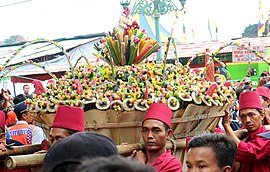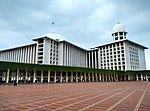Sekaten

Sekaten(Javanese:ꦱꦼꦏꦠꦺꦤ꧀;from theArabicwordsyahadatain) is a week-longJavanesetraditional ceremony, festival,fairandpasar malam(night market) commemoratingMawlid(the birthday of theIslamic prophetMuhammad), celebrated annually started on 5th day through the 12th day of (Javanese Calendar) Mulud month (corresponding toRabi' al-awwalin Islamic Calendar).
The festivities usually took place in northernalun-alun(square) inYogyakarta,and simultaneously also celebrated in northern alun-alun ofSurakarta.This ceremony originally were initiated by SultanHamengkubuwana I,the founder ofYogyakarta Sultanateto promote theIslamicfaith.[1]
Gamelan Sekaten
[edit]On day one, the ceremony commences after the Isya evening prayer with a royal procession of royal guards and 'abdi dalem' court officials accompanying two sets of centuries old gamelan traditional music instruments, the Kyai Nogo Wilogo and Kyai Guntur Madu. The royal procession, led by the Sultan and Governor of Yogyakarta or his representative, begins in Pendopo Ponconiti, the main hall of Kraton Yogyakarta and proceeds towards Yogyakarta Great Mosque in northern Alun-Alun. The Kyai Nogo Wilogo gamelan will be placed at the northern pavilion of Grand Mosque, while Gamelan Kyai Guntur Madu will be placed at Pagongan pavilion in southern side of the mosque. These two set of sacred gamelans will be played simultaneously everyday until the 11th day of Maulud month through seven consecutive days. During the last day the two gamelans will be returned into the Kraton.
The Gamelan Sekaten of Surakarta are played in the same manner as their Yogyakarta counterparts, and are brought out to the mosque and returned to the palace in a royal procession led by the Sunan of Surakarta and the Mayor and City Council of Surakarta.[2]
Tumplak Wajik
[edit]Two days before Grebeg Muludan, the ceremony calledTumplak Wajikwas held in palace Magangan field in 4:00 PM afternoon. This ceremony is started bykotekanceremony which incorporate singing traditional songs accompanied with rhythmic hitting ofkentongan(bamboo or woodenslit drum) andlumpang(rice mortar and pestle), that marked the making ofGununganwhich will be carried inGrebeg Muludfestival. The traditional Javanesekuecalledwajikwhich is diamond-shaped sticky rice in palm sugar, is an essential part of this ceremony, and included withingununganoffering. The song played in this Tumplak Wajik ceremony is usually the popular Javanese traditional songs, such as Lompong Keli, Tundhung Setan, Owal awil.
Grebeg Muludan
[edit]In Yogyakarta, the main event of Sekaten is called theGrebeg Muludanthat held in 12th day (exactly during the birthday of Muhammad) starting in 8:00 am. The mainGunungan(Javanese: mountain), a model of mountain made of sticky rice, sweets, various foods, crackers, fruits and vegetables, were guarded by 10 units ofbregodo(brigade) of the royal guards of the palace (the companies underHis Majesty's Kraton Guard Regiment): Wirobrojo, Daeng, Patangpuluh, Jogokaryo, Prawirotomo, Nyutro, Ketanggung, Mantrijero, Surokarso, and Bugis Companies, together with the Royal Guard Battalion of the Duchy ofPakualaman.
TheGununganwill be carried in processions from Kemandungan through Sitihinggil and Pagelaran hall and finally ended in Grand Mosque. After the prayer, the Gunungan that symbolize the wealth and prosperity ofMataram Sultanatewill be picked, fought over and ripped apart by the people that already waiting in the square, as they believed this objects is sacred, potent and could bring good luck, prosperity and wealth upon their households. Usually these parts of Gunungan will be kept in the house for luck, or buried in the rice fields as the traditional Javanese farmers believed that these objects will grant their fields fertility and protection from locust, plagues, and any misfortunes that might befell them.
References
[edit]- ^see other versions of the source -"A short history of the 'Sekaten' festival",Asia Africa Intelligence Wire,Financial Times Ltd, 2004-04-03,retrieved30 November2017[dead link]
- ^Adnan, Abdul Basit Haji (1996),Sejarah masjid agung dan gamelan sekaten di Surakarta,Yayasan Mardikintoko,retrieved30 November2017

